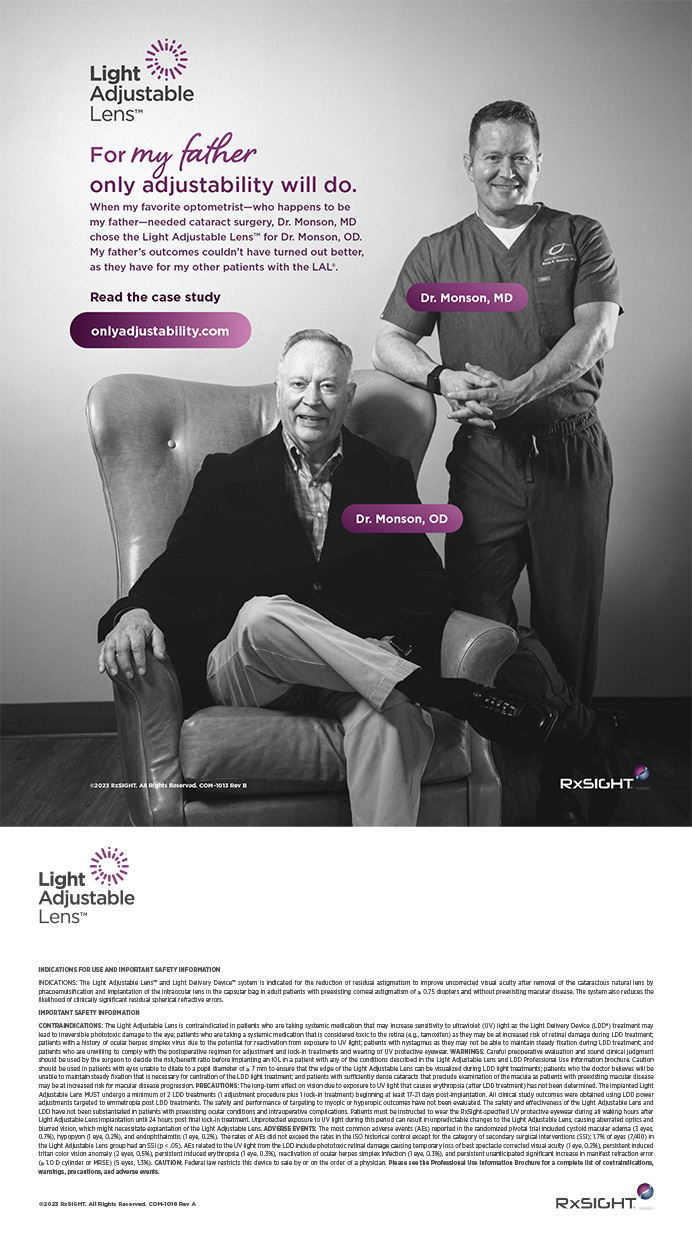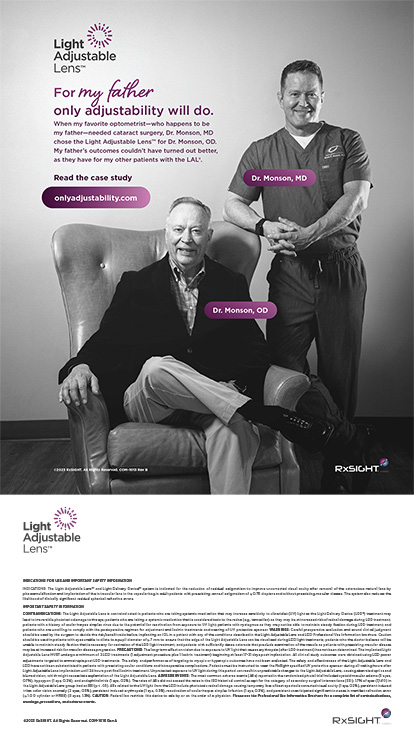CASE PRESENTATION
A 5-year-old girl presents with markedly subluxated lenses, the edges of which bisect the pupil in both eyes (Figure 1). Her BCVA is 20/200 OU. Based on a challenging social situation and her poor prior compliance with spectacles, contact lens management is deemed unlikely to succeed.
Presuming a plan of bilateral removal of the lenses, please comment on the following for surgery on the patient's first eye:
- Would you implant an IOL if you could place a Cionni Capsular Tension Ring (CTR) or an Ahmed Capsular Tension Segment (both manufactured by Morcher GmbH [Stuttgart, Germany], the former distributed in the United States by FCI Ophthalmics, Inc. [Marshfield Hills, MA], the latter not available in the United States)? If so, what refractive target would you select and why?
- Would you consider implanting a multifocal IOL?
- If the capsular bag could not be used to stabilize an IOL, would you place an IOL with another means of fixation? If so, what type?
UDAY DEVGAN, MD
The primary question in this case regards the nature of the disease. If it is due to trauma, then we can probably assume that there will be no progressive zonular damage. A Cionni CTR would provide one point of suture fixation of the capsular bag to the sclera, and two Ahmed Capsular Tension Segments would provide two points for even more stability. If the subluxation is due to Marfan's syndrome, homocystinuria, or another systemic condition, then more zonular loss will likely occur in the future.
This patient may benefit from a small-gauge pars plana lensectomy (Figure 2) with direct suture fixation of the IOL to the iris or sclera without preservation of the capsular bag, which is likely to become opacified and fibrosed in a child. The aforementioned approach would avoid that scenario. Scleral-fixation sutures may not last the patient's lifetime, so iris fixation might be a better long-term option. ACIOLs are yet another option, but their placement would warrant careful monitoring of the corneal endothelium to avoid future decompensation.
My lens of choice in this patient would be an iris-sutured three-piece acrylic monofocal IOL. My postoperative goal would be slight hyperopia so that, as the patient ages and the axial length increases, she will progressively become mildly myopic. I would not choose a multifocal IOL in this situation because of the difficulty of ensuring its centration and the unpredictability of the final refractive state of the eye as the child grows.
Cases such as this one are challenging, and a team approach between retina, cataract, and pediatric specialists is often best.
GARRY P. CONDON, MD
I would consider surgery. Based on the patient's current BCVA of 20/200, I would not choose any lens other than a monofocal IOL. The clinical picture could represent anything from a simple ectopia lentis to myriad congenital zonulopathies—in this patient, a severe case.
If the macula is normal, my refractive goal would be plano in the patient's first eye with the subsequent initiation of accepted therapy for amblyopia. If her BCVA is reduced due to a hypoplastic macula, I would consider a more myopic refractive goal for added magnification at near, and I would accept some additional progressive myopia over the next several years.
If the lens is spherical and the subluxation is inferior, the chance of salvaging the bag regardless of available hardware is remote. In that case, I would elect posterior iris fixation of a foldable three-piece acrylic IOL in conjunction with a limbal or pars plana lensectomy. With a more sectoral zonulopathy, I might consider a modified ring fixation, but I would avoid a posterior capsulorhexis/anterior vitrectomy with that scenario. Not performing a vitrectomy might allow some pseudoaccommodation in a child of this age.
If the surgery in the patient's first eye proved successful, I would operate on the fellow eye in exactly the same manner as in the first. Aggressive therapy for her amblyopia is, of course, critical regardless.
ALAN S. CRANDALL, MD
The fact that the lens is completely circular implies that there is almost no zonular support, unlike in most cases of pediatric Marfan's syndrome in which the opposing zonules are generally quite strong. This observation is important when planning the surgery. I would still plan, however, to use a Cionni CTR with two eyelets.
In this setting, initiating the capsulorhexis often requires microinstrumentation and a bimanual capsulorhexis technique. After starting the capsulorhexis, the surgeon can use iris hooks to center the lens. Ahmed Capsular Tension Segments can help center the lens, but a CTR will still be needed.1 I would normally have a refractive target of slight hyperopia (+1.00 D) in a 5-year-old to allow for ocular growth.
I usually do not implant multifocals IOLs in this setting, because centration of this type of lens is critical, as is leaving no residual astigmatism. These eyes, however, frequently have significant astigmatism. Also, I would worry about the patient's second eye. Sometimes, the fellow eye has a different outcome and does not have an intact capsular bag, which could lead to problems related to the placement of one multifocal lens and one monofocal lens.
If I could not use the capsular bag, my usual approach would be to perform iris fixation.2 The IOLs could be exchanged at a later date for power, which could be an advantage.
Section Editors Robert J. Cionni, MD; Michael E. Snyder, MD; and Robert H. Osher, MD, are cataract specialists, Dr. Cionni at The Eye Institute of Utah in Salt Lake City and Drs. Snyder and Osher at the Cincinnati Eye Institute in Ohio. They may be reached at (513) 984-5133; msnyder@cincinnatieye.com.
Alan S. Crandall, MD, is a professor, the senior vice chair of ophthalmology and visual sciences, and the director of glaucoma and cataract for the John A. Moran Eye Center at the University of Utah in Salt Lake City. He acknowledged no financial interest in the products or companies mentioned herein. Dr. Crandall may be reached at (801) 585-3071; alan.crandall@hsc.utah.edu.
Garry P. Condon, MD, is an associate professor of Ophthalmology at Drexel University College of Medicine in Pittsburgh. He acknowledged no financial interest in the products or companies mentioned herein. Dr. Condon may be reached at (412) 359-6298; garrycondon@gmail.com.
Uday Devgan MD is in private practice at the Maloney Vision Institute in Los Angeles. Dr. Devgan is also the chief of ophthalmology at Olive View UCLA Medical Center and an associate clinical professor at the UCLA School of Medicine. He acknowledged no financial interest in the products or companies mentioned herein. Dr. Devgan may be reached at (310) 208-3937; devgan@ucla.edu.
- Vasavada V, Vasavada VA, Hoffman RO, et al. Intraoperative performance and postoperative outcomes of endocapsular ring implantation in pediatric eyes. J Cataract Refract Surg. 2008;34(9):1499-1508.
- Kopel AC, Carvounis PE, Hamill MB, et al. Iris-sutured IOLs for ectopia lentis in children. J Cataract Refract Surg. 2008;34(4):596-600.


